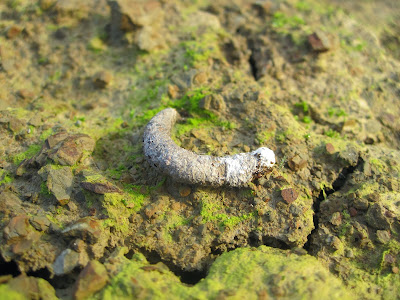Gatwick Landscape Photographer of the Year
(self-appointed)
Sunrise: 07:45 December 9th 2013
Gosh...
Spider webs on Dock seed heads, North West Zone
Oh my...
Rough grassland and hedgerows, North West Zone
Goodness me...
Frost in the rough grassland, North West Zone
Ok, that's enough of that. On Monday morning, we began our Winter Bird Survey transect in the rough grasslands, north of the runway. I was accompanying Tom Forward of Gatwick Greenspace and volunteer James, for whom this was a first venture into birding.
Rambling rosehips in the hedgerows
The open areas of grassland were mostly quiet and still, with bird activity being concentrated in the hedgerows. In the mud, there were plenty of animal tracks; clues as to who else had recently passed by...
Roe Deer tracks: the rear dew-claw marks are just about visible
Moorhen tracks
The hedgerows looked pretty awe-inspiring in the winter sun. Every section seemed to contain at least one singing Song Thrush; pretty unusual as spring is the normal time for staking out territories. A flock of around 10 Meadow Pipits broke the relative peace, peeping frantically overhead before settling in the hedgerows furthest from us.
Listening for thrushes in the hedgerows
Reed Buntings were in good numbers, hiding away in the tall Reed Canary Grass and then flitting up into the scrub. A Robin and a Dunnock were actively singing; a few Redwing were 'tseeping'; and mixed flocks of Great, Blue and Long-tail Tits nosily contact-called while foraging.
Blackthorn fruits (i.e. Sloe berries) and lichen
Approaching the first bend in the River Mole, a Moorhen squawked its presence and a Pied Wagtail passed overhead in bouncing flight. Our first flock of Fieldfare, a winter-visiting thrush from northernmost Europe, were nosily chatting away in the large Oaks overlooking the floodplain. On a bare patch of earth near the grassy slope, a Green Woodpecker had left its usual calling card...
In certain light, even bird poop can look quite marvelous.
Break it open and you will find the chitinous remains of ants
We had a poke around in the reed beds but sadly no signs of Water Rail, so Tom regaled us with an ear-splitting impression (although neither James nor I were really qualified to critique it). Still scattered around in the grass were feathers from the dead Grey Heron found earlier in the week - the foxes had an early Christmas dinner!
Scrub West of Brockley Wood
Entering the scrub west of Brockley, a bout of action could be heard in the woodland margins with brawling Song Thrushes and a jeering audience of Redwing. Rounding the corner of the woodland, where the river passes close by, a mixed flock of Fieldfare and Redwing were happily foraging in the Hawthorn scrub.
Candlesnuff Fungus on river driftwood
Beginning our second transect further downstream along the Mole, Chaffinch, Goldfinch, Magpie and Reed Bunting were all in abundance. We also picked up a new first for this birding transect: a lone Rook. These birds are generally common around the airport so it is by chance they haven't cropped up earlier on our survey.
Continuing up the corridor of grassland along the river, we then entered a Fieldfare battle-zone! They were zipping back and forth over the river, between the lines of scrub and trees. Sounding rather like fighter plane machine-guns, one even let loose a small, tactical aerial-attack (fortunately though not directly overhead!).
Towards the end of transect 2, we paused to watch a brightly coloured Jay perched just a few meters ahead, posing proudly with acorn in beak. A moment later, there was a flash of orange and a Kingfisher appeared up on the tree. Then, it shot past us upstream, showing off its electric blue upper-side and bullet-like profile. We were also greeted by the lumbering flight of an impressive Grey Heron, moving off downstream... For James, these were two species he had never seen up-close, so well worth the early morning start!
Our two transects

















No comments :
Post a Comment